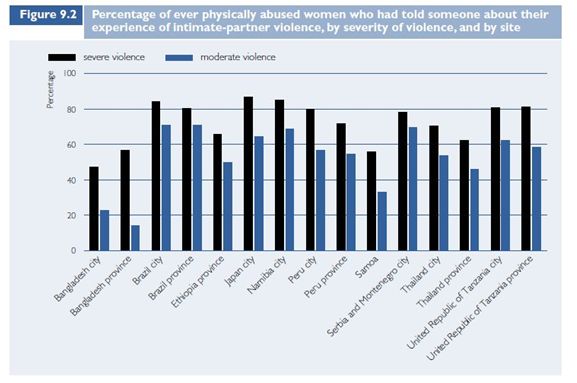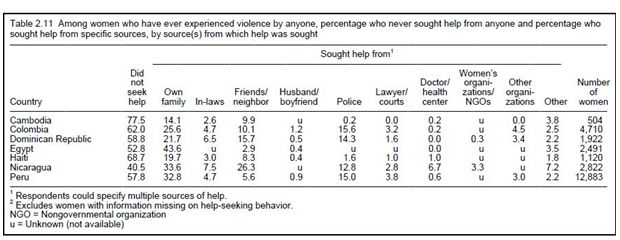Many abused women first access informal supports from family and friends, and may never seek more formal services such as those offered by shelters, social workers and police. Help seeking is an interactive process that unfolds over time and usually includes multiple attempts from different sources, involving complex decisions regarding whether to leave and end an abusive relationship in cases of domestic violence; and determining how and which services are sought (Anderson & Saunders, 2003; Barrett & St. Pierre, 2011; Cattaneo et al., 2007; Duterte et al., 2008; Fanslow & Robinson, 2010; Ford-Gilboe et al., 2005; Macy et al., 2005). These studies reinforce findings of help-seeking from larger population-based surveys on prevalence of physical and sexual violence against women (WHO, 2005; Demographic Health Surveys; and the International Violence against Women Surveys).

Excerpt: WHO. 2005. Multi-country Study on Women's Health and Domestic Violence against Women. WHO, Geneva.

Excerpt: Kishor, Sunita and Kiersten Johnson of ORC Macro, MEASURE DHS. 2004. Profiling Domestic Violence; A Multi-Country Study. Calverton, Maryland.
Effective strategies for safety planning vary from woman to woman, although those linked with shelter services may be more likely to improve safety (Goodkind et al., 2004). Women living in rural areas may have additional barriers to accessing shelter services, such as lack of information, lack of transportation and concerns about confidentiality (Krishnan et al., 2004; Haller 2004; Lobmann, et al., 2005; Riddell et al., 2009).
Additional barriers may also be faced by women of colour, women with disabilities and immigrant and refugee women. These include the fear of prejudices from agencies and judgment by service providers (e.g. perceptions that women from specific groups will not leave their abusive partners for cultural reasons or generalizations about certain communities). Many women experience multiple barriers to help-seeking and service provision, involving logistical and financial challenges, tactics imposed by perpetrators, social stigma and fear (Forte et al., 2005; Yoshihama, 2002; Hyman et al., 2006; Latta & Goodman, 2005; Weisz, 2005; Helfferich et al., 2004; Fugate et al., 2005; Zweig et al., 2002).